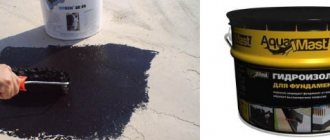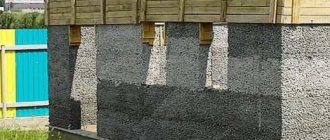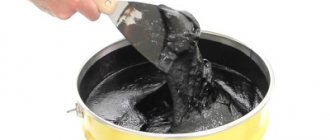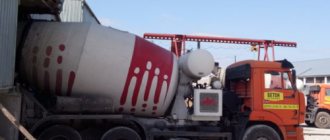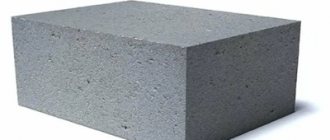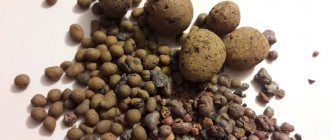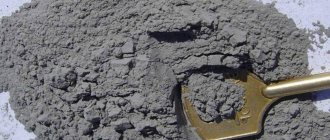What are expanded clay concrete blocks according to GOST
Expanded clay concrete is classified as lightweight concrete. A porous material, expanded clay, is used as a filler. These are round granules made of baked clay. The composition of expanded clay concrete is cement, sand, expanded clay and water. When preparing the mixture, more water is poured than in ordinary heavy concrete, since expanded clay is hygroscopic and absorbs liquid. When producing blocks, the finished mixture is poured into molds, left until initial hardening, after which they are removed from the mold. In principle, the blocks are ready, but they cannot be used until they reach their design strength.
Compound
Making expanded clay concrete mixture yourself is not difficult. The main thing is to maintain the proportions of the components of the solution, which depend on the purpose of the material.
Standard proportions of the components of ceramic concrete:
- 1 share of cement;
- 2 shares of sand;
- 5 shares of expanded clay.
Additionally, sawdust or ash can be mixed into expanded clay concrete.
Concrete proportions table.
When making ceramic concrete, the dry components are initially thoroughly mixed without water, and only then with liquid. You can make this mixture yourself. To prepare expanded clay concrete mixture, it is recommended to use only clean cold water, because... impurities impair the hardening of concrete. When using contaminated water, a white coating will appear on the surface of the finished products, so it is better to use drinking liquid.
If you need to make building blocks, you will need special molds. The prepared mixture is poured into them, compacted using a vibration device, and if necessary, the required amount of solution is added. After pouring, the products are kept in the fresh air for a week.
Composition and proportions
Without a doubt, expanded clay concrete is currently one of the most popular building materials. The composition per 1 m³ should include the following components:
Read also: Calculation of import customs duties
- Cement mixture.
- Sand.
- Fine expanded clay, which is created on the basis of natural raw materials.
- Water without all kinds of impurities and chemicals. It should be noted that in no case should you use water with an acidity below pH 4 to dilute the mixture. You should also not use sea water, as it can lead to the appearance of a white coating.
Also, the composition of expanded clay concrete (proportions per 1 m³ are calculated in advance at the construction site) may include several additional additives, such as sawdust, wood ash and plasticizers.
In order for the future building mixture to meet all requirements, it is necessary to adhere to the following recommendations and rules:
How to set up a production line
In order to organize a line for the production of expanded clay concrete and KB blocks, it is necessary to go through several stages:
1. Select and purchase all the necessary equipment. To minimize costs, you can rent it or purchase it used.
2. Find and conclude agreements with the nearest suppliers of the necessary raw materials.
3. Find a room for setting up a workshop and bring all the necessary communications to it.
The production technology is quite simple to organize. It consists of preparing the mixture, forming blocks, drying them and storing them.
- To prepare the solution, you need to take expanded clay, water, sand, M400 cement and plasticizer in the required proportions. The last component can be ordinary liquid soap.
- To obtain the mixture, you should use a concrete mixer with a capacity of 130-150 liters.
- In summer, the production of mixtures and blocks can be organized in an open area, the main thing is that a 220 V line is connected to it.
The next section of the article will tell you what is cheaper, warmer and better (foam concrete or aerated concrete, or expanded clay concrete) and in general which one to choose from.
Proportions of raw materials for the manufacture of mixtures of various types and areas of use
In order to produce material with different average densities and different purposes, it is necessary to maintain certain proportions. Let's take a closer look.
To fill expanded clay concrete floors, the solution must be prepared in compliance with the following proportions:
- One part cement;
- Three parts sand;
- Four parts of expanded clay.
For screed
In this case, the brand of solution will be M100. If we express this ratio in kilograms, it turns out that for 25 kg of expanded clay it is necessary to use 30 kg of sand-cement mixture.
Note! The method of filling the floor may be different. It distinguishes between semi-dry, dry and wet screed. We looked at the proportions for the last option.
The proportions for the structural material are as follows:
- 1.5 parts sand;
- One part cement;
- One part of expanded clay.
In order to make lightweight material, you must use the following proportions (for making 1m3):
- 250 kg of cement;
- 130 liters of water;
- 720 kg of expanded clay.
Sand can be added, or you can do without it.
Application area
Based on the listed capabilities and characteristics, specific conclusions can be drawn regarding the use of expanded clay concrete. This material successfully copes with the following tasks:
- Construction of walls during low-rise construction.
- Screed device. Recommended ratio: 2 parts material and 1 standard CPS solution.
- Floor slabs are distinguished by their ease of thermal conductivity. The only drawback is its relative fragility.
As a result, we have an inexpensive material with good performance, which does not have many disadvantages:
- Afraid of direct exposure to water.
- Still, additional measures are required to insulate the walls.
- It is impossible to create a perfectly flat surface. It will have to be leveled separately using plaster mixtures.
- Handicraft production is widespread. Therefore, it is better to purchase goods from trusted suppliers.
Size of expanded clay concrete blocks
By size, expanded clay concrete blocks are usually divided into:
- wall;
- septal
It is clear that the former are used for laying external walls. They must have certain strength and density indicators, which will be discussed further. In size they can be 288*138*138, 288*288*138, 290*190*188, 390*190*188, 190*190*188, 90*190*188 mm. According to their fullness, they are either full-bodied or hollow.
Partition blocks , as the name suggests, are used for laying internal partitions. They have less weight, which reduces the load on the foundation. In size, as a rule, partition blocks are produced in 590*90*188, 390*90*188, 190*90*188 mm.
Some enterprises produce blocks that do not correspond to the dimensions indicated above - they are made not according to GOST, but according to specifications, which the manufacturer himself can determine for himself. As a rule, large-format blocks are produced according to specifications.
Separately, it is worth noting the facing blocks , which are produced by some enterprises. They have dimensions of 600*300*400 mm, are produced by adding dyes to the solution and have a relief decorative surface.
Advantages of expanded clay concrete
The first thing that attracts builders to this material is its low cost compared to brick and most types of concrete blocks. Expanded clay concrete is characterized by low weight. This not only simplifies the installation process, but also eliminates the need for an expensive foundation.
Expanded clay provides low thermal conductivity. The structure of the finished material is porous and retains heat well. In modern conditions, the use of energy-saving construction technologies is especially important. Expanded clay concrete does not contain harmful and dangerous components that have a negative impact on the environment or human health. To ensure its long service life, it is necessary to take care of additional insulation from the negative effects of moisture. It is important to correctly calculate the upcoming loads to select the optimal brand. By observing the recommended standards and requirements, you can achieve a long service life of finished objects.
Technical characteristics and properties
The main properties and characteristics of this material are:
- Durability . It is determined by the grades of the material; the higher it is, the higher the loads the material can withstand.
- Density _ As this property increases, strength also increases. It can range from 500 to 1700 kg/m³.
- Porosity . It shows the ratio of the volume of a material to the volume of its pores.
- Water resistance . The coefficient indicates the degree of resistance of the material to water.
- Thermal conductivity . It shows the extent to which a material is capable of transmitting heat flow through itself. For expanded clay concrete it is higher than for building bricks.
- Fire resistance . The material is able to withstand temperatures of 1000 °C for a long time without changing its structure.
- Frost resistance . When water gets into the pores and freezes, it increases in volume and destroys any rock. Expanded clay concrete is capable of withstanding a fairly large number of such cycles.
- Volumetric mass . It depends on the amount of filler in the material. Expanded clay concrete can be particularly light, light and heavy.
Cost per 1 m³
Expanded clay concrete is an affordable building material. To make it yourself, you will need to purchase expanded clay.
- And this will cost from 1000 to 1900 rubles per 1 m³. The smaller the fractions, the higher their price will be.
- When purchasing ready-made expanded clay concrete, you need to pay about 3-4 thousand rubles for 1 m³. (depending on the class of material).
For more than 60 years, this material has been actively used in low-rise construction. And since then it has managed to prove itself quite well in different climatic conditions.
This video will tell you how construction using expanded clay concrete blocks occurs:
Monolith made of lightweight expanded clay concrete
xanchez FORUMHOUSE Member
My wife and I are builders by training, thanks to which the sold “kopeck piece” did not sink into oblivion without a response, and my small carpentry workshop largely set the “style” of the then future house - a lot of wood (windows, ceilings, floors, stairs), Almost everything is made from larch. There wasn't much money, but the end result seemed to work out well.
A project published in one of the specialized magazines was taken as a basis; during the adjustment process, it underwent minor changes.
The foundation of TISE is bored piles with a diameter of 250 mm, at a depth of 1.7 meters the base expands to 600 mm, since the foundation “walks” by an average of 5 cm, the blind area is made sliding, with a minimum gap. The thickness of the walls is 400 mm, the thickness of the partitions is 120 mm.
Composition of large-porous expanded clay concrete
Due to the fact that the raw materials are of different quality (volume density, moisture level, grain size, strength of the cement mass may change), there are no exact proportions of the components.
Having expanded clay and cement, their best ratio is determined experimentally.
It is necessary to increase the amount of cement until the moment when the fracture of the experimental sample passes not between the granules, but also along them. This means that maximum strength of the material is obtained with minimal cement consumption.
The approximate composition of large-porous expanded clay concrete is as follows:
- per cubic meter of expanded clay concrete material you need about one hundred and twenty kilograms of cement (grade not lower than M 400, otherwise to obtain the proper strength you will have to increase the mass of the material);
- water is carefully added - the cement laitance should seem to envelop the expanded clay grains and remain on their surface without flowing down. The mixture should not separate.
Expanded clay concrete: characteristics
This material has the following qualities:
- strength;
- long service life;
- safety for human health;
- lightness - relatively low weight allows you to expand the choice of foundation;
- installation - does not require a frame during construction;
- interacts well with any finishing materials;
- not exposed to sunlight;
- fire resistance;
- does not emit toxic substances when heated;
- frost resistance – withstands temperature changes;
- relatively low cost;
- not susceptible to mold and mildew;
- vapor permeability;
- heat and sound insulation.
Types of expanded clay concrete blocks
Density of expanded clay concrete
One of the important indicators is the density of the material. Depending on the density, expanded clay concrete is divided into three groups.
| View | Description |
| Bespeschany | Produced without adding sand. Typically, material of this density is used to construct walls, floors and ceilings. |
| Porous | Used for making blocks. In turn, it is divided into three subspecies: · thermal insulation – used as additional insulation for walls; · thermal insulation and structural – used for laying partitions; · wall – for the manufacture of engineering structures. |
| Dense | It is characterized by a high cement content and combines the characteristics of porous and sandless types. However, this type of expanded clay concrete is practically not used in construction due to the high cost of the resulting material. |
Kinds
Porous block structure
Brands of expanded clay concrete
The brand is the very indicator that influences the choice of a given material. Depending on the fractions of the initial components and the composition of expanded clay concrete, several grades are distinguished.
| Brand | Application |
| 50 | Pouring partitions and load-bearing walls. |
| 75 | |
| 100 | As a filler for floor screed. |
| 150 | For blocks. |
| 200 | For block material of light floors. |
| 300 | For the construction of bridges and roads. |
Brand and use of expanded clay concrete
Marking
Expanded clay concrete weight
The weight of a standard expanded clay concrete block is about 15-16 kg. Depending on the size and type of block, the weight may either decrease or increase.
Standard sizes
Note: It is also worth noting that adding only small expanded clay granules during the manufacturing process affects the weight of the finished block - it increases.
Kinds
The most popular brands of expanded clay concrete are M100, M200 and M300. However, if necessary, grades with a higher density are also available. All of them can be divided into:
- Dense expanded clay concrete;
- Sandless;
- Porous.
The most common material in low-rise construction is the sandless type. It is actively used for pouring floors, erecting ceilings and walls. Less common is the porous type of expanded clay concrete, which in turn is divided into three subtypes:
- Constructive;
- Thermal insulation;
- Thermal insulation and structural.
The dense look combines the properties of the previous two. It consists of a large amount of cement, which makes it stronger and more expensive.
Application of expanded clay concrete
The main direction in the use of expanded clay concrete is the construction of walls.
Expanded clay concrete walls can withstand compressive loads of up to 7 MPa, and the density of the material is about 1000 kg per cubic meter. Expanded clay concrete is also used when constructing screeds in cases where high thermal insulation and sound insulation are required. Expanded clay concrete screed significantly reduces costs and increases the speed of drying and hardening of the material
Floor slabs are made from expanded clay concrete, using dense expanded clay concrete, which contains a high percentage of cement. The installation of reinforcement and metal lathing is recommended.
Production and use
The production of expanded clay concrete is carried out in special mixers with forced mixing, which do not destroy the structure of the original components during operation. The duration of the kneading can be within 3-6 minutes. We talked about how to make expanded clay concrete with your own hands in a special article.
The versatility of the material has given it a wide range of applications.
- But in most cases, expanded clay concrete is used to create blocks and erect walls.
- It is also actively used in the manufacture of floor screeds, when it is necessary to achieve high levels of sound and heat insulation.
- It is also possible to produce floor slabs, which are also in demand in the construction of houses.
Read on to find out whether it is possible to set up a line for the production of expanded clay concrete blocks.
This video will tell you what mistakes are most often encountered when laying expanded clay concrete:
Characteristics of expanded clay concrete and its brand
The main characteristics include the brand and density of the material. The indicators are complex and depend on the composition of expanded clay concrete and the fractions of the feedstock. Each brand is used for its intended purpose:
- M50 - used when pouring partitions in a house or arranging a load-bearing wall;
- M75 – load-bearing structures are manufactured in residential and industrial premises. In this case, monolithic technology is used;
- M100 - the properties are such that the material is excellent for filling screeds;
- M150 – used in the manufacture of blocks;
- M200 (v15) - block material and lightweight flooring options are prepared from this composition;
- M300 - used in the construction of bridges and roads.
Based on density, the material is divided into three groups:
1. Sandless - gravel, water and cement composition are used for production; sand is not added. The main advantage is reasonable cost. Application in construction - used in the construction of walls, floors and ceilings in low-rise buildings.
2. Porous - blocks are made from M20 solution. Based on strength, there are three subtypes of expanded clay concrete:
- thermal insulation – d400 – d700 – used as additional insulation for walls;
- body-insulating and structural – from d800 to d1 400, used for insulation or when laying partitions;
- wall – d1 400 – d2 000, various engineering structures are made from it.
3. Dense - contains an increased amount of cement composition, combining the characteristics of sandless and porous compositions. The price of the material is high; it is rarely used in the construction industry.
There is another option for classifying the composite composition - by volumetric mass. According to this criterion, expanded clay concrete is divided into three groups:
- heavy - strength indicator is 25 MPa, volumetric weight is 1,200 - 1,400 kg per cubic meter;
- light - weight is 800 - 1,000 kg, the composition contains lightweight expanded clay material with a low specific gravity;
- especially light - the weight of one cube is from 600 to 1,800 kg, the strength is 7.5 - 40 MPa. As a filler, instead of crushed stone, you can add expanded clay, ash gravel, and slag pumice to concrete.
Production of expanded clay concrete
The material is obtained by mixing the main components. These include concrete, sand, expanded clay in a ratio of 1:2:3. Ingredients are selected in accordance with regulated requirements. Solid blocks are produced with expanded clay from 5 to 10 mm, hollow blocks - up to 20 mm.
During the mixing process, fine-grained dry components are first introduced, then water. Lastly, expanded clay granules are added. For the production of bricks, a solution is used in which the fractions are evenly coated with a concrete glaze. The mixture for filling the floor has a more liquid structure.
The industry produces expanded clay concrete in the form of finished products of various brands. They differ in characteristics and areas of application.
Comparison with other concretes
In order to compare expanded clay concrete, aerated concrete and foam concrete, it is necessary to study in detail their properties, advantages and disadvantages.
Aerated concrete
The advantages of aerated concrete include:
- Light weight.
- Installation using special glue.
- High thermal insulation.
- Ease of installation.
- Vapor permeability.
- Environmental Safety.
When using aerated concrete, the structure has 1.7 times less weight than using expanded clay concrete.
Flaws:
- Fragility.
- Large absorption of moisture, which destroys its structure.
- Low frost resistance.
Expanded clay concrete
The advantages of this material include:
- High coefficients of strength and thermal conductivity.
- Affordable price (much lower than gas and foam concrete).
- Better thermal insulation and strength than aerated concrete.
- Resistance to frost and moisture is better than other lightweight concretes.
- Environmentally friendly.
- No shrinkage.
Flaws:
- Its fragility does not allow its use in multi-story construction.
- Thermal insulation is less than that of aerated concrete.
Foam concrete
The advantages of this building material are:
- Environmental Safety.
- Low thermal conductivity, provided that the blocks have been manufactured taking into account all requirements.
Flaws:
- Foam and aerated concrete must be laid only with special glue. If you use standard cement mortar, their properties and characteristics will be an order of magnitude less.
- Shrinkage. If the foundation was built with errors, then the masonry made of foam concrete and aerated concrete will soon crack during shrinkage.
Based on the study of all three materials, it can be assumed that expanded clay concrete is not only a more affordable material, but also has better properties and technical characteristics. You will learn further about the cost of expanded clay concrete and blocks per cubic meter (1 m3) and the price per 1 m2.
What is expanded clay concrete?
Concept and features
The main material in the production of expanded clay concrete is expanded clay. It is foamed baked clay, which is not only environmentally friendly, but also has fairly high strength. At the same time, with increasing density, the strength of the material increases.
In addition to expanded clay, expanded clay concrete includes sand, cement, water and a plasticizer. The main component can be obtained from any clay deposit; the ease of installation and production has made this material the most popular among lightweight concretes.
We will tell you further about the pros and cons of expanded clay concrete according to consumer reviews.
Advantages and disadvantages of the material
This material has been actively used for about 60 years, and in this relatively short time it has managed to prove itself on the positive side. Expanded clay concrete has a number of advantages:
- Light weight . The mass of one block is two times less than the same volume of brick. Thanks to this property, there is no need to build a complex foundation. In addition, the walls and design blocks of the blocks reduce the shrinkage process to a minimum.
- High strength . This indicator may differ depending on the block type. The possible load on such material can be equal to 10 tons.
- Resistance to external influences . Expanded clay concrete has high levels of frost resistance, sound and heat insulation. It is also environmentally friendly and fire resistant.
- Availability . A house made of expanded clay concrete will cost much less than one made of other materials. This is due to the absence of the need for additional heat and sound insulation, rental of additional equipment and tools, and also due to the speed of construction.
The disadvantages include:
- The porous structure provides less strength than ordinary concrete.
- Getting inside the material, moisture slowly begins the process of its destruction.
The video below will tell you more about the benefits of expanded clay concrete:
Reviews from experts
There are difficulties in working with large-porous expanded clay concrete. As follows from the reviews, it is characterized by increased sensitivity to the quantity and quality of the components used in preparation.
The preparation of CPCB directly on the site and the construction of walls from it is a complex process for ordinary builders; it implies the presence of an experimental selection of materials and a high cultural level of work.
Such nuances limit the dissemination of the material in question. But there is still positive experience in constructing objects from large-porous concrete, even with the use of expanded clay.
